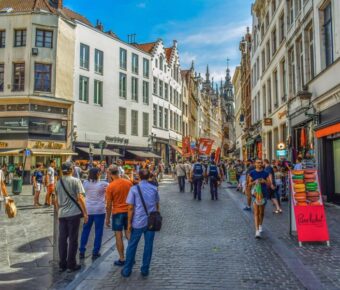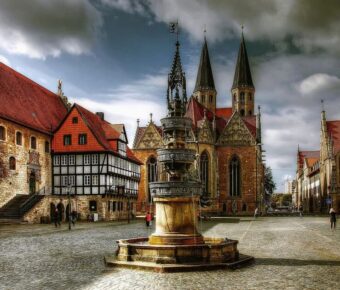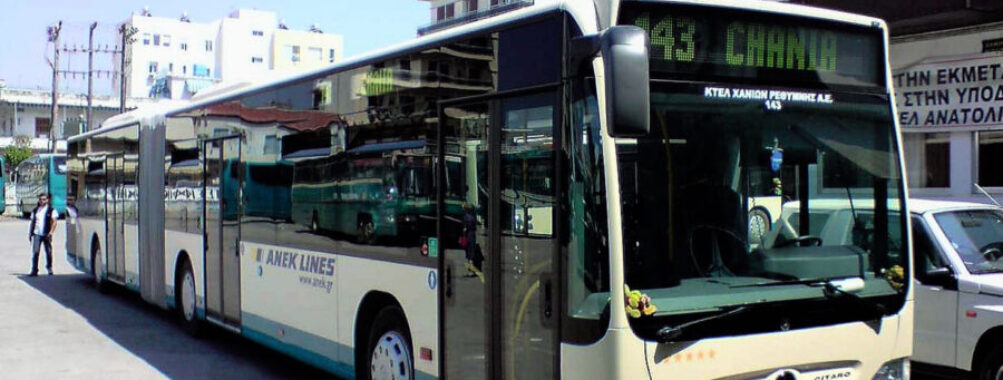
Crete Bus Schedule: 7 Insider Tips to Navigate Routes Like a Local in 2025
Taking the bus in Crete? It’s honestly a game-changer for your trip—whether you’re hopping between ancient ruins or chasing sunsets in sleepy seaside towns.
Crete’s public bus system links up the big cities like Heraklion and Chania with even the tiniest villages. It makes getting around without a car both easy and cheap.
Some of my best days on the island started by just jumping on a local bus, letting it surprise me. I’ve got stories about getting off at the wrong stop and stumbling onto a hidden taverna—wouldn’t trade those for anything.
If you’re staring at Greek place names and wild timetables, don’t worry. I’ll walk you through how to read them, plan your routes, and dodge the usual rookie mistakes (I’ve made plenty, trust me).
With a bit of inside knowledge, you’ll reach Crete’s must-see spots and friendly hidden gems—no stress, no rental car, just easy-going Greek travel.
Table of Contents
- Key Takeaways
- Overview of Crete’s Bus Network
- Intercity vs Local Bus Services
- Key Bus Operators and Stations
- Understanding Bus Timetables
- Heraklion Bus Travel Guide
- Heraklion Bus Stations and Connections
- Routes from Heraklion to Key Destinations
- Heraklion City Buses and Local Transit
- Chania Bus Travel Guide
- Chania Bus Station Information
- Popular Routes from Chania
- Exploring East Crete by Bus
- Routes to Agios Nikolaos and Elounda
- Sitia, Vai, and Zakros Connections
- Southern and Remote Destinations by Bus
- Getting to Palaiochora, Sougia, and Sfakia
- Connections to Ierapetra, Makrigialos, and Chrissi Island
- Access to Matala and Messara
- How to Read and Use Bus Schedules
- Finding Up-to-Date Timetables
- Seasonal Variations and Holiday Schedules
- Major Attractions Accessible by Bus
- Knossos and Historical Sites
- Balos Lagoon, Elafonisi Beach, and Natural Wonders
- West Crete by Bus: Unique Experiences
- Georgioupolis and Villages
- Samaria and Agia Roumeli
- Agia Irini Gorge Adventures
- Connections to Ferries, Taxis, and Other Transport
- Integrated Travel and Island Hopping
- When to Consider Taking a Taxi
- Insider Tips for Bus Travel in Crete
- Best Practices for Tourists
- Staying Near Major Bus Stations
- Bus Travel Etiquette and Useful Info
- Ticketing and Luggage Policies
- Accessibility and Special Needs
- Frequently Asked Questions
- Where can I find the latest KTEL bus timetable for Crete?
- How can I obtain a map of Crete’s bus routes?
- What’s the frequency of the green KTEL buses between major Cretan cities?
- Can I travel effectively around Crete using the public bus system?
- Is there a hop-on hop-off bus service available for tourists in Crete?
- What are the evening bus options available from Chania to Heraklion?
- Book Your Dream Experience
- More Travel Guides
Key Takeaways
- The Crete bus network reaches almost every corner of the island
- Reading schedules and planning ahead makes travel smoother
- Buses connect you to both main sights and off-the-beaten-path places
Overview of Crete’s Bus Network

Crete actually has a surprisingly big and practical bus network for an island. If you want to skip the rental car, buses really are your best bet.
They’re cheap, they run more often than you’d expect (especially between the main towns), and they’ll drop you pretty much where you need to go.
Intercity vs Local Bus Services
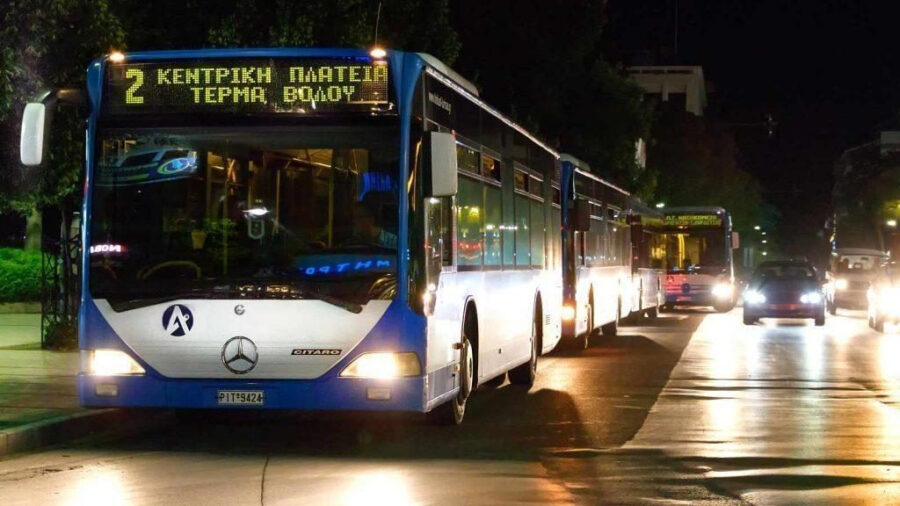
You’ll spot two main types of buses on Crete: Intercity (KTEL) buses and local city buses.
Intercity buses zip between the major cities like Heraklion, Chania, Rethymno, and Agios Nikolaos. They even reach out to smaller villages and some “off the tourist trail” beaches.
I always thought it was cool how intercity buses can take you up to mountain villages or straight to the coast—no drama.
Local buses mostly stick to the cities and nearby neighborhoods. In Heraklion or Chania, you’ll see blue or green buses running from supermarkets to outlying areas.
They’re perfect for short trips, like popping to Knossos or the airport. If you’re traveling between towns, though, you’ll want those KTEL intercity coaches—think comfy seats, not city shuttles.
Just don’t mix them up at the station. The signs can be a little confusing (been there), so double-check before you board.
Key Bus Operators and Stations
KTEL is the big name you’ll see everywhere—kind of like Crete’s public transport superhero.
There are two companies: KTEL Heraklio–Lasithi and KTEL Chania–Rethymno. Each covers a different chunk of the island, but you can usually transfer between their routes without much trouble.
Main bus stations sit in the bigger cities. In Heraklion, you’ll find the central bus station on Efessou Street (locals just call it “KTEL”). Chania’s station sits right in the city center, across from the municipal market.
You’ll also find smaller terminals in Rethymno and Agios Nikolaos. Most stations sell tickets at a window—just a heads-up, the queue can get wild in high season!
Honestly, I kind of love people-watching at these stations. You’ll spot local grandmothers with market bags, confused tourists (yep, like us), and sometimes even a sheep or two if you’re heading deep into the countryside.
There’s a certain buzz at Crete’s bus stations you don’t get elsewhere.
Understanding Bus Timetables
Crete’s bus timetables are… well, let’s just say they’re a mixed bag.
Intercity buses usually run more often between bigger cities in summer. For example, between Rethymno and Heraklion, you’ll often see departures every hour from early morning till late evening.
Once winter hits, the schedule gets trimmed down.
You’ll spot printed timetables at every station, but they’re sometimes a bit out-of-date. I always check the KTEL website for the latest times, especially if I’m catching an early or late bus.
Here’s the thing—timetables aren’t set in stone. Buses might show up five or ten minutes late, or sometimes leave a minute or two early if they’re full. It’s a bit of a gamble.
One rookie mistake: don’t assume buses run super late! Most services wrap up in the evening, so don’t get stranded with the sunset like I did once.
Always double-check the last bus time if you’re planning a long day out.
Heraklion Bus Travel Guide
Getting around Heraklion by bus is pretty straightforward once you know how the main stations work and which routes go where.
You’ll pick up on local habits and shortcuts pretty quickly—I definitely had my share of learning moments, armed with just a paper ticket and some loose change.
Heraklion Bus Stations and Connections

The main Heraklion Bus Station A sits about a 10-minute walk from the city center, close to the harbor and Heraklion Port.
This is the big hub for long-distance routes—think trips to Chania, Rethymno, and those cute mountain villages you probably never heard of before landing in Crete.
If you’re heading out on a regional journey or just want to check the big schedule board (which honestly reminds me of train stations in Europe), this is where you start.
For southern routes, like Matala or Mires, you’ll find Bus Station B (Chanioporta).
Local buses and connections run between these two main stations, so sometimes you’ll have to change lines. Don’t hesitate to ask for help; station staff are used to tourists, and I’ve found them surprisingly patient (maybe the coffee helps).
Pro tip: Always check for last-minute schedule changes. The boards in the stations are sometimes more up-to-date than the websites.
Especially in spring and fall, schedules can shift fast—I can’t count how many times I’ve stood at the wrong platform thinking, “Is this bus invisible or what?”
Routes from Heraklion to Key Destinations
From Bus Station A, buses head all over Crete every day.
Want to see Chania’s old harbor or shop in Rethymno’s alleyways? There’s a bus for that. Major intercity lines include:
| Destination | Typical Journey Time | One-way Fare (approx.) |
|---|---|---|
| Chania | 3 hours | €13-14 |
| Rethymno | 1.5 hours | €7-8 |
| Matala | 2 hours | €8-9 |
Seats usually don’t sell out except in mid-summer or on weekends, but I’d grab tickets early just in case.
You can buy at the station ticket desk or online if you’re the digital type. And honestly, nothing beats the view from the right-side window heading west—the coastline suddenly reminds you you’re on an island.
Buses also connect Heraklion to the airport and port with no fuss. It’s less than 20 minutes to both, and airport shuttles run every hour.
You skip the taxi line, which can get pretty wild when ferries arrive.
Heraklion City Buses and Local Transit
City buses in Heraklion cover most neighborhoods, beaches, and even the big Knossos archaeological site.
Blue and white buses start early and run until late (though don’t count on midnight rides in the off-season). The main lines all pass through the city center, but stops like Chanioporta and the port are especially handy for transfers.
It’s best to buy tickets before boarding from the little kiosks or shops—look for the “ΕΙΣΙΤΗΡΙΑ” signs. Prices are usually under €2.
A tip I learned the hard way: If you buy from the driver, it costs a bit more and they might not have change, especially for big bills.
Local buses get packed with students, grandmas with shopping, and tired ferry passengers. And honestly, you’ll need to wave your hand to signal the driver to stop—otherwise, they might just sail right past.
Nothing like a morning game of “Will my bus stop for me?” to wake you up.
Chania Bus Travel Guide
Getting around West Crete is way easier than most people think.
Chania’s buses are reliable, affordable, and will drop you in some truly stunning places—perfect if you don’t have (or want) a rental car.
I’ve explored Chania and its old town more times than I can count, and trust me, catching a local bus is a lot less intimidating once you know the basics.
Chania Bus Station Information
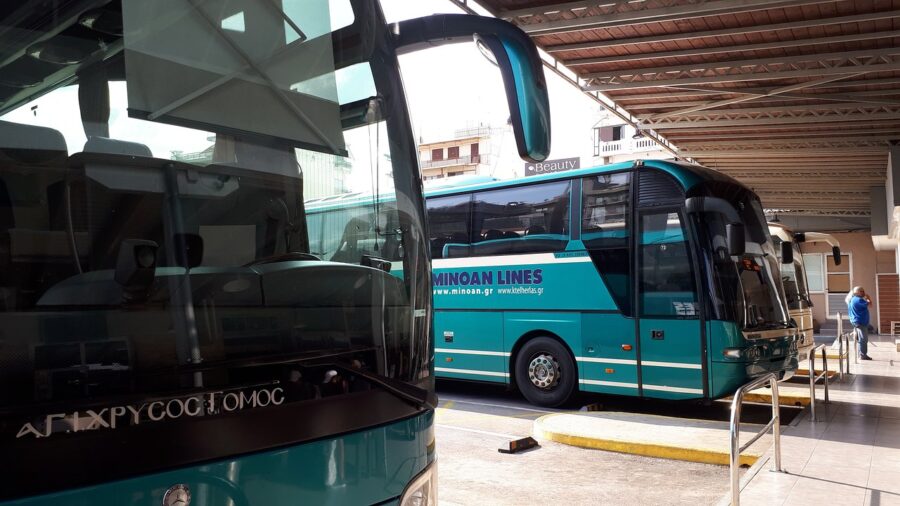
The main Chania bus station—officially KTEL—sits at 1866 Square, right in the heart of the city.
It’s a busy hub, not far from the old town, and just a short walk from Cocoon City Hostel. Even if you get lost in the winding streets, locals usually point you in the right direction.
The station has ticket counters, digital screens (sometimes only in Greek—fair warning!), a small café, and restrooms. There’s a spot to grab a quick coffee while you wait.
I wish I’d known on my first visit that tickets are almost always cheaper from the counter than on the bus. Plus, check the printed timetables posted by the doors—the schedule can change with the seasons.
One more tip: Buses can fill up fast in summer, so getting there early isn’t just smart, it’s kind of necessary.
If you use the Chania Urban Bus app, you can check live routes and even buy tickets. It’s a lifesaver when your Greek is, well, a little rusty.
Popular Routes from Chania
Chania bus routes reach pretty much everywhere you’d want to see in West Crete. Some of the most popular include:
- Chania to Rethymno – Frequent service, under 90 minutes. Perfect for day trips.
- Chania to Heraklion – Longer ride, but it gets you to Knossos and the big city sights.
- Chania to Georgioupolis/Kavros/Bali – Awesome if you want to check out quieter beaches and little villages.
- Local buses – Fast way to reach the old town, the port, or even the airport. No need for taxis if you’re patient.
What I love is the variety—buses stop at tourist spots and tiny inland towns, so you get a peek at authentic Crete life out the window.
Fares are cheap, and you can stash your bag in the undercarriage on longer routes (a relief if you overpack like me).
If you want to really explore Chania and beyond on a budget, riding the bus gives you stories you’ll actually remember.
Exploring East Crete by Bus
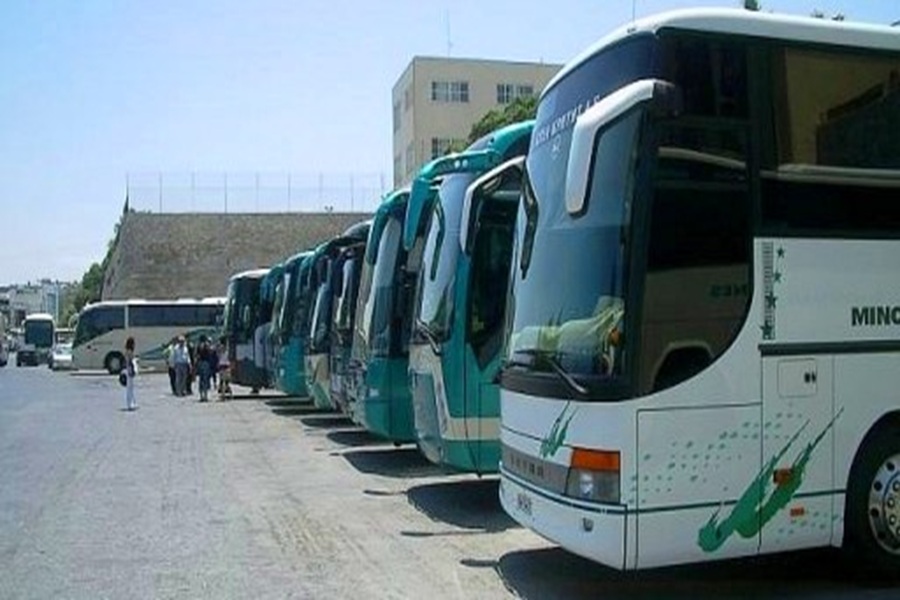
East Crete pulls you in with its relaxed villages and some of the most unique beaches far from the main tourist drag.
Getting around by bus isn’t just affordable—it’s part of the adventure here, with trips winding through small mountain towns and along the coast.
Routes to Agios Nikolaos and Elounda
Taking the bus east from Heraklion toward Agios Nikolaos is honestly one of my favorite rides on the island.
It’s not just about getting from A to B—you get a full coastal show along the way. Buses run several times a day in summer, with clear signs at the Heraklion bus station.
Once you reach Agios Nikolaos, it’s a handy hub for Elounda. Local buses to Elounda are frequent, and you’ll usually find them leaving from the main square or bus stop—just ask a local or look for the little blue bus signs.
If you want to check out Spinalonga Island, this area is the jumping-off point, so it’s worth snagging a window seat.
Here’s a quick tip: I like to bring snacks because the ride is gorgeous but can get long if you miss the main connection.
The bus drops you next to the lake in Agios Nikolaos, so if you’re not in a rush, take a lakeside stroll.
Sitia, Vai, and Zakros Connections
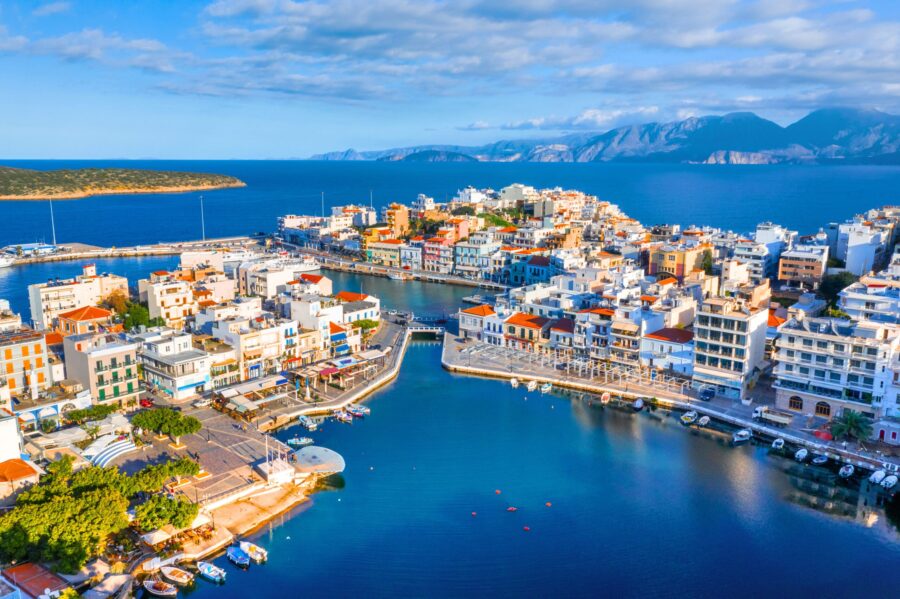
Head east toward Sitia and you’ll notice the buses get a bit sparse, but with some planning, you can still make it work. Sitia feels like a sleepy town at the end of the line, a last little outpost for travelers who want to see what’s beyond the usual stops.
The main bus from Agios Nikolaos to Sitia is pretty comfy and winds through some mountain villages you’d probably never see otherwise. From Sitia, you can catch a bus up to Vai Beach—that Vai Beach with the palm forest, yes, it’s real and as dreamy as everyone claims.
Don’t expect buses every hour, though. I once found myself waiting in Sitia for a late-afternoon bus, but honestly, it worked out because I reached Vai just as the crowds started fading away.
If Zakros or Kato Zakros is your goal (maybe for the Zakros Gorge hike), you’ll find buses, but schedules get tricky—especially outside summer. Sometimes there are only a couple of departures the whole day.
I’d suggest grabbing your ticket as soon as you reach Sitia if you’re aiming for Zakros in summer—seats disappear fast.
Pro tip: Check AllinCrete and the public KTEL site for current bus times, or just ask at the station—it’s usually the simplest way. Chat up the bus driver if you can; I’ve gotten some of my best Crete tips from drivers who know all the hidden spots.
Southern and Remote Destinations by Bus
Exploring Crete’s southern coast by bus is totally possible, but you’ll need to plan ahead. Some routes run less often than the busy northern ones, and once you head south, the landscape gets wild and dramatic in a hurry.
Getting to Palaiochora, Sougia, and Sfakia
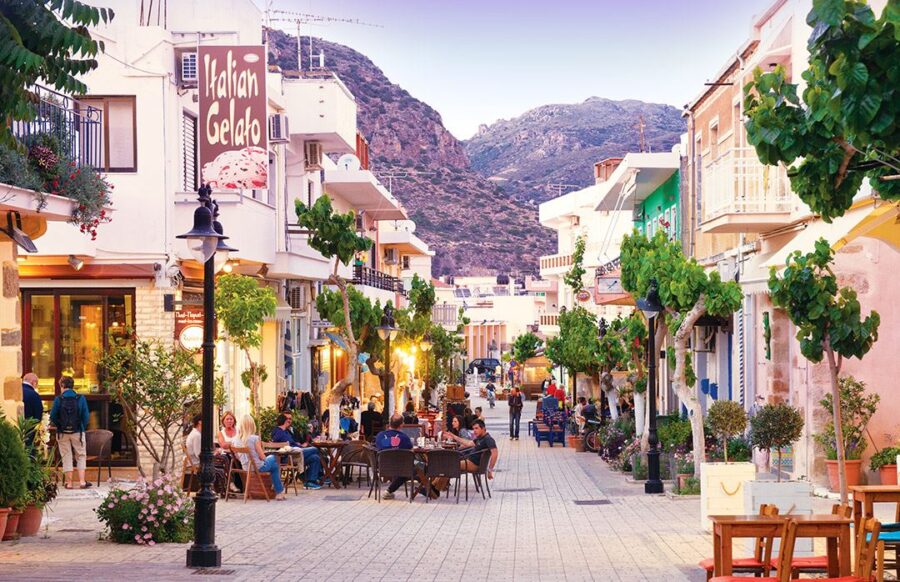
If you want to get to Palaiochora, Sougia, or Sfakia, you’ll almost always start from Chania’s main bus station. These routes attract hikers and beach lovers, especially during the summer rush.
Buses fill up fast, and on weekends, seats can sell out before you know it. I usually buy my ticket a day ahead if I need to be somewhere on time.
Palaiochora and Sougia sit on the Libyan Sea, and the ride there winds through some serious mountains. The trip’s slow, but the views from those cliff roads are worth it—unless you get carsick, then, well, good luck.
For Sfakia, buses stop in villages and usually line up with the ferry if you’re heading to Loutro or Agia Roumeli.
- Tip: Most buses to these towns don’t run late. Double check the last return so you don’t get stuck after dark.
- Personal Note: I never skip the early bus from Chania to Sfakia—the sunrise over the mountains is honestly something else.
Connections to Ierapetra, Makrigialos, and Chrissi Island

To reach Ierapetra by bus, you’ll need to start from Heraklion or Agios Nikolaos. There are a few departures every day, but anything beyond Ierapetra gets more local and less predictable.
Ierapetra sits at the southern tip of Europe and life moves at a slower pace here, for sure. If you’re heading to Makrigialos, you’ll connect through Ierapetra—buses aren’t frequent, so always check the board at the Ierapetra KTEL station.
For Chrissi Island, take the bus to Ierapetra first, then hop on a boat. Boats to Chrissi mostly run late spring to early autumn and usually match up with bus arrivals.
- Checklist:
Access to Matala and Messara
Matala is famous for those hippie caves, but it’s not exactly close to Heraklion. Buses leave a few times a day from Heraklion’s main station, passing through the Messara valley and towns like Mires.
Mires is kind of a crossroads—people get off here for other villages or to visit archaeological sites. I’ve found this route pretty reliable most of the year, but weekends in summer can get packed with teens and backpackers.
Driving through Messara is a green, olive-filled break from the rocky north. If you’re heading to villages like Pitsidia or Timbaki, some buses will drop you on the main road and you’ll walk or grab a taxi from there.
| Destination | Departure City | Bus Frequency | Notes |
|---|---|---|---|
| Palaiochora | Chania | 2-3 times daily | Buy tickets early in peak season |
| Sougia | Chania | Limited daily | Scenic; links to ferry for Samaria hikers |
| Sfakia | Chania | 2-3 times daily | Aligns with ferry timings |
| Ierapetra | Heraklion/Ag. Nik. | Several daily | Connects to Makrigialos and Chrissi boats |
| Matala | Heraklion | Handful daily | Passes through Mires; check return times |
How to Read and Use Bus Schedules
Reading bus schedules in Crete takes a bit of patience (and maybe some luck), but you’ll get there. Knowing where to find the latest info will save you stress, and remembering the quirks of seasons and holidays really helps your travel plans.
Finding Up-to-Date Timetables
If you’re a planner, Crete’s bus timetables can test your patience. Websites like e-ktel.com and ktelherlas.gr are where you’ll find schedules for different parts of the island.
They’re kind of clunky and honestly, they might drive you up the wall, but they’re still the best resource before you arrive. Some bus stops in Crete still do things the old way—paper schedules taped to boards.
You might think, “Why not just check online?” but these paper posters are often more accurate than what you’ll find on the web. Don’t hesitate to ask the ticket clerk or another traveler—locals usually know what’s up, and other tourists are just as confused as you.
Quick tip: Always double-check departure times, especially if you’ve got a tight connection or a flight. Crete bus schedules are more like guidelines than strict rules.
Where to check:
| Source | Usefulness | Quirks |
|---|---|---|
| Bus company websites | Mostly current | Often confusing interface |
| Bus stop posters | Usually accurate | Can be outdated or missing |
| Ticket office | Reliable | Sometimes language barrier |
Seasonal Variations and Holiday Schedules
The bus schedules in Crete shift with the seasons, and that trips people up all the time. In peak summer, you’ll see buses nearly every hour to the big beaches and tourist towns—even some mountain villages get extra service.
But when October comes and tourists leave, routes get cut back—sometimes with barely any warning. Greek public holidays can throw a wrench in the works, too.
Timetables might shrink or disappear for a day. One summer in Chania, I waited an hour for a bus to Elafonissi that never showed—nobody bothered to post a “no service today” sign.
Ask locals or your hotel staff about changes during holidays, it’s worth it. Always check the schedule at both ends of your trip, not just at your starting point.
I missed the last bus back to Heraklion once because I assumed the evening times matched the morning—rookie mistake. If you’re unsure, take an earlier bus and give yourself some wiggle room. That’s honestly the best way to deal with buses in Crete.
Major Attractions Accessible by Bus
You can reach most of Crete’s highlights by bus, so you don’t really need a car to see the island’s best bits. The network covers historic sites, gorgeous beaches, and even some offbeat gems.
Knossos and Historical Sites

Knossos sits just outside Heraklion, and if you’re staying in town, the bus is the easiest way to get there. Grab the Number 2 bus from Heraklion’s central station and it drops you right by the entrance.
If you’re into myth and history, Knossos is a must-see. The ruins sprawl across the site, and some parts have been rebuilt—controversial, maybe, but it does help you picture what was there.
Give yourself time to wander. The main areas can get packed, but I always duck into the quieter corners to escape the crowds.
Buses also head out to Arkadi Monastery and the winding old streets of Rethymnon. Both work for a half-day trip, and I always tell people Rethymnon Old Town is perfect for grabbing a gyro and strolling the lanes without having to worry about parking.
Balos Lagoon, Elafonisi Beach, and Natural Wonders
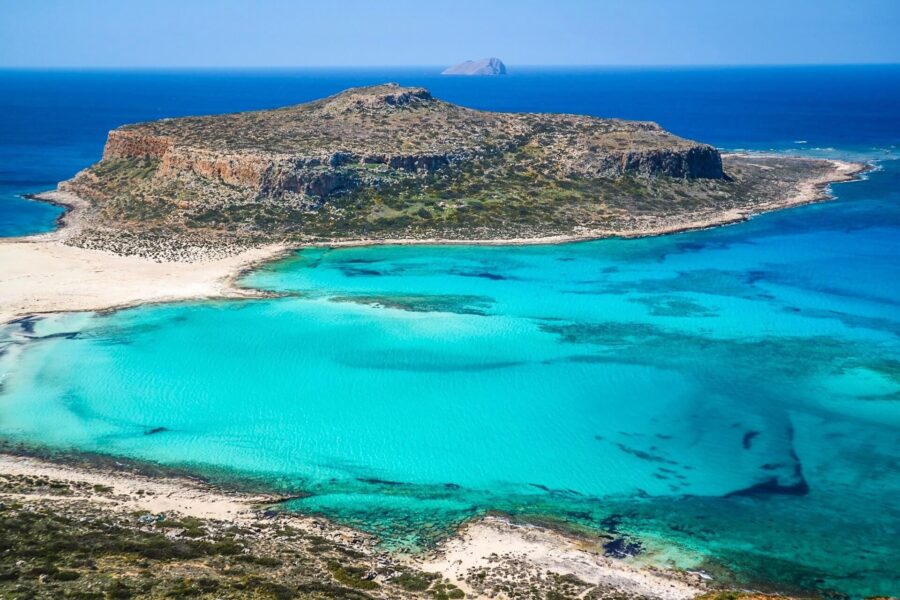
I’ve met plenty of travelers who think you need a rental car to see Crete’s natural wonders, but buses can get you there. Balos Lagoon is a bit more of a mission—you’ll take a bus from Chania to Kissamos, then hop on a boat or shuttle.
Honestly, that bus ride is half the fun, with wild scenery rolling past your window. Elafonisi Beach is simpler.
In summer, regular buses from Chania take you right to the sand. You step off and suddenly you’re standing on that famous pink beach.
If you’re like me, you’ll spend half the day floating and the rest just soaking up the view. Bring good shoes, though—the sand gets scorching.
Spinalonga Island is an easy trip too: bus to Elounda, then a quick ferry. And then there’s Samaria Gorge—Crete’s classic trek.
Catch the early bus from Chania to Omalos, hike down, jump on the ferry to Sfakia, then grab another bus back. It’s a long day but totally worth it.
If you find yourself in some tiny village along the way, take time to explore—Case dei Delfini is a hidden spot in Rethymnon that’s almost impossible to find unless you get a bit lost, but those are the best adventures, aren’t they?
West Crete by Bus: Unique Experiences
Taking the bus around West Crete is honestly underrated. It’s slower, sure, but you notice all the little things—olive groves shimmering, locals waving, goats perched on rocks.
Some of these rides drop you at beaches, gorges, and villages you’d never spot from a car or tour group.
Georgioupolis and Villages
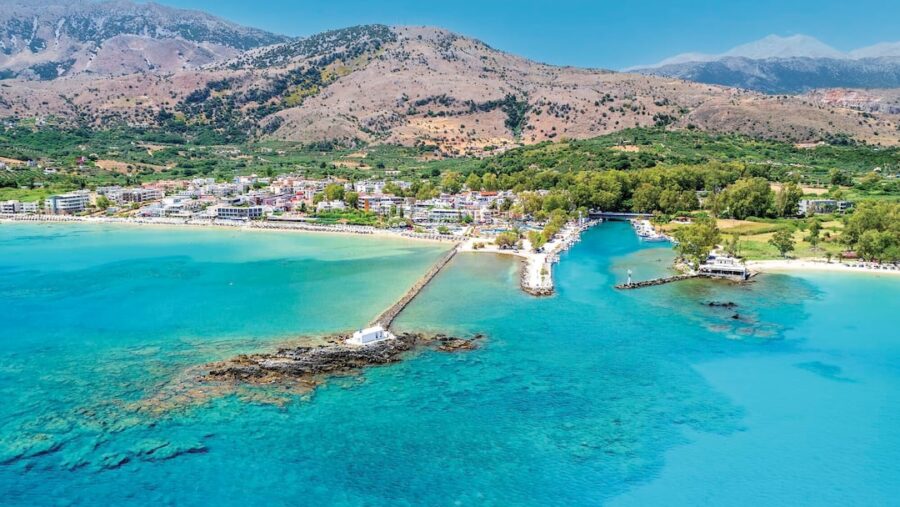
Georgioupolis is one of those places you stumble into if you’re bouncing around on the bus. The main square is shaded by eucalyptus trees, and the vibe just feels more real than at the big resorts.
Local buses from Chania or Rethymno take you right into the village—you can step off and be on the beach in minutes. There’s a river, a tiny fishing harbor, and even a little white chapel on a rock that every photographer seems to love.
If you like wandering, buses also head to nearby villages like Vrises and Lake Kournas (bring a picnic, make a day of it). I honestly prefer this way of traveling; you spot homemade signs, chatty bakers, and cafes with mismatched chairs serving the best coffee for a euro.
| Departure Point | Change Needed | Beach Access | Notable Stops |
|---|---|---|---|
| Chania | No | Yes | Lake Kournas, Vrises |
| Rethymno | No | Yes | Kavros, Episkopi |
Samaria and Agia Roumeli

Everyone raves about the Samaria Gorge hike—honestly, it deserves the hype—but the bus ride is its own adventure. You start ridiculously early (seriously, pack snacks!), grabbing one of the KTEL buses from Chania.
Those switchbacks feel wild, and I never manage to nap—the mountain views just won’t let you.
After the gorge, you’ll land in tiny Agia Roumeli. No roads reach it, just ferries and footpaths.
Hikers sprawl out at the seafront tavernas, sipping cold drinks and comparing battered boots. Ferries from here link you back to buses at places like Chora Sfakion or Sougia.
But honestly, if you skip that bus ride, you’re missing half the story.
Quick Tip: Buy your return bus ticket ahead of time during peak months. Trust me, I’ve been stuck waiting when I didn’t!
Agia Irini Gorge Adventures
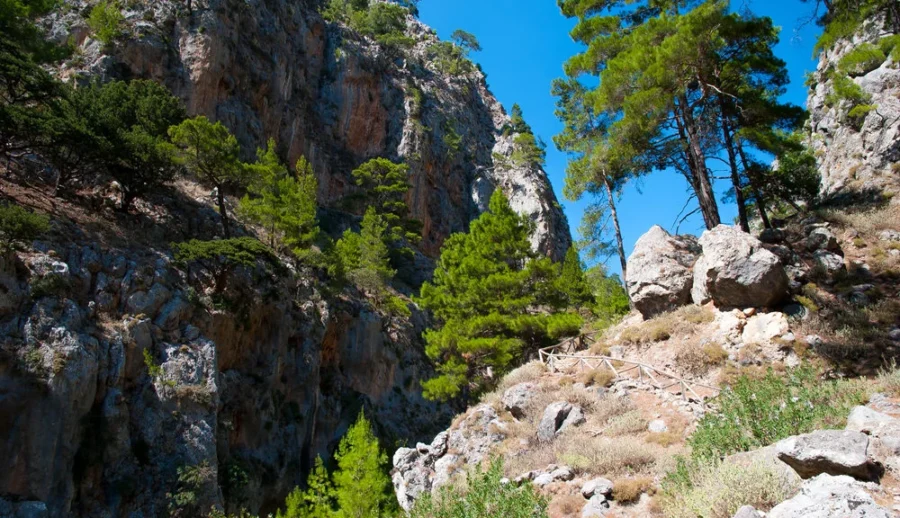
Agia Irini Gorge feels like Samaria’s little sister—fewer crowds, but just as wild. The trail’s shorter, so you won’t feel totally wrecked at the end, but you still get those steep limestone walls and that amazing pine smell.
It’s easy enough to catch a bus from Chania to Agia Irini village, right at the trailhead.
I’ve noticed the crowd here is different—mostly locals and a handful of hikers who want to dodge the big tour groups. After you finish, the bus at Sougia takes you back, but don’t rush.
Grab lunch at one of the little tavernas—fresh fish, chunky Cretan salad, bread that’ll haunt your dreams.
If you want a glimpse of the “real” Crete, this route is a gem. And honestly, the conversations you overhear on the ride back—often in three languages—make the bus ticket worth it.
Connections to Ferries, Taxis, and Other Transport
Crete’s public buses let you link up with ferries, taxis, and even rental cars—if you time things right. You can plan your journey to avoid long waits or missed connections, but you’ve got to know a few quirks first.
Integrated Travel and Island Hopping
Crete isn’t one of those tiny Greek islands; getting around means mixing buses, ferries, and sometimes a sweaty walk or two. Most big ferry ports—Heraklion, Chania, maybe Rethymno—sit close to main bus stations.
Here’s something I learned the hard (and sweaty) way: bus stops for the big ferry lines are usually just outside the port gates, but “just outside” can mean weaving through a busy lot with your suitcase.
Schedules usually match up with high-traffic ferry arrivals, but not always. Always double check the bus time if you’re catching an early or late boat.
Popular ferry links (think Santorini or Athens) attract loads of bus traffic. If you’re coming off the boat with a crowd, buses fill up fast—I’ve been left behind before.
During busy months (June–September), buy your ticket in advance or at least get in line early.
Quick checklist for smoother connections:
- Check bus-ferry sync schedules at KTEL/port kiosks
- Pack light for those port walks
- Bring euros—some drivers just won’t take cards
When to Consider Taking a Taxi
Sometimes the bus schedule just doesn’t line up with your plans. Maybe your ferry lands at midnight, or you miss the last bus to a quiet village. That’s when a taxi really saves the day.
Taxis cluster around all the ports and airports, and I’ve found most drivers are friendly—not pushy.
If you’re loaded with bags or wrangling kids, taxis spare you the hassle of dragging everything through crowded stations. Just a heads up—fares can spike late at night or if you’re heading way off the main highway.
But if you’re splitting the cost with two or three people, it’s not so bad.
You can grab a taxi straight off the rank, or book ahead with apps—some drivers even use WhatsApp now. My go-to move: if there’s a big line at the official stand, I’ll walk a block or two out of the port’s main exit.
Taxis there sometimes dodge the pirate fare queue and you’ll get moving faster.
Sometimes you just want peace of mind after a long journey, especially when connections are tight or you’re landing somewhere new after dark. Always ask for the meter, or agree on the fare before you hop in.
Insider Tips for Bus Travel in Crete
Taking the bus in Crete saves you money and gets you closer to the local vibe. A little planning makes a big difference, and knowing where you’re sleeping can change your whole trip.
Best Practices for Tourists
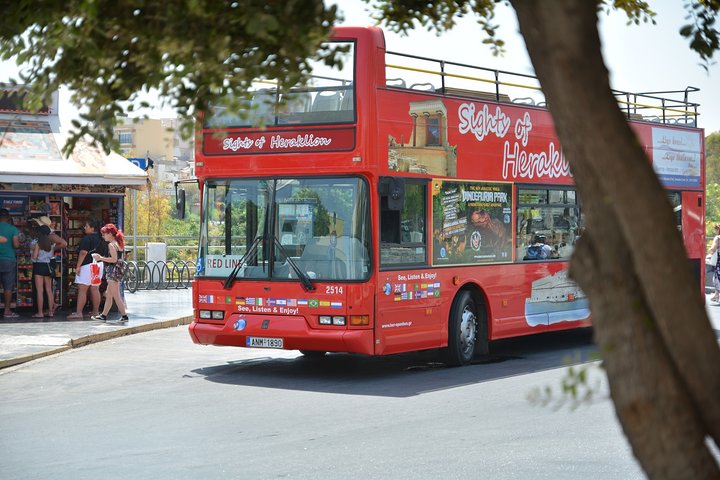
Always keep small euro coins handy. Most Cretan buses don’t accept cards, and drivers get grumpy about big bills.
When you board, tell the driver your stop—even if it seems obvious. A bit of friendliness goes a long way, and sometimes, drivers will remind you when it’s time to get off.
Timetables look precise, but don’t trust them blindly. Cretan buses are “relaxed,” especially on rural lines—they might leave a few minutes early or late.
Show up 10-15 minutes before the scheduled time, just to be safe.
If you’re not sure about the route or time, ask locals at the stop or someone at your hostel. Sometimes people post real-time tips in group chats like the Crete Secrets Facebook group.
Don’t assume buses run late at night. If you’re out past 10pm in a small town, double-check your ride home or be ready to call a taxi.
Staying Near Major Bus Stations
Pick a hotel or hostel near a main bus station—it’ll save you so much hassle. I learned this the hard way on my first trip.
Places like Cocoon City Hostel are literally minutes from Chania’s main bus station, so you can roll out of bed and hop on the first bus.
Heraklion, Chania, and Rethymno have well-marked KTEL bus stations that work as central hubs. The main lines—like Heraklion to Rethymno or Chania—leave from here almost every hour.
You’ll find luggage storage, ticket counters, and sometimes even a little café for coffee while you wait.
If you’re doing lots of bus travel, map out your base near the station—even if you lose a bit of “old town charm.” Every extra five minutes on foot is extra stress with heavy bags, especially in the summer heat.
It’s a huge perk for early morning trips or late returns. Nothing beats starting your day with a pastry and a short walk, seat secured—while others are still trekking across town.
Bus Travel Etiquette and Useful Info
When you ride the bus in Crete, a few small things can make your day way smoother. Details like how you buy a ticket or what to do if you need extra help can really shape your experience.
Ticketing and Luggage Policies
You can buy a ticket before you get on, usually at kiosks or ticket booths near bigger bus stations. In smaller villages—like Anogia—you just pay the driver directly.
Don’t stress, that’s totally normal. Just have cash ready, since cards are rarely accepted.
Once you’re on, keep your ticket handy. Bus staff might check during the ride.
If you lose it, you could get fined, and that’s a headache you don’t want.
Luggage is simple: small bags go overhead or on your lap; larger suitcases get stored under the bus. The driver helps with that.
Be polite—say thanks, even if it’s just “efharisto.” Extra or bulky items might cost a bit more, and I’ve seen people surprised by that.
One tip from personal mishap: label your luggage. I nearly sent mine to Heraklion when I was headed for Rethymno.
Luckily, the driver caught it—could’ve been one of those “funny later” stories.
Accessibility and Special Needs
Most main city buses in Crete have low steps or a ramp, but rural routes and older vehicles often don’t. If you need specific help or space for a wheelchair, call ahead.
Some bus services try to help, but not every route is set up equally.
There usually aren’t audio announcements for stops, so let the driver know your destination—especially in places where stops are “request only.” In Anogia and other small towns, drivers are used to helping out foreign visitors, but a little Greek greeting always helps.
If you have special needs—like traveling with a guide dog or needing a seat near the door—ask at the ticket office or tell the driver. Most are understanding, but don’t expect every convenience you’d find in bigger cities.
Patience (and a smile) does wonders.
Local buses in the villages (I’ve learned the hard way) fill up fast at school times, and you might not get a seat. Early mornings are your best bet.
Frequently Asked Questions
Getting around Crete by bus is easier than you might think, but figuring out routes and timetables can feel chaotic if it’s your first time. Public buses connect every major city and town, but the schedule and comfort can be a bit quirky.
Where can I find the latest KTEL bus timetable for Crete?
You’ll find the latest timetables on the KTEL Crete website. They update things pretty often, especially before and during summer.
Honestly, the website isn’t always the easiest to use—sometimes you’ll see more up-to-date times posted at local stations. I like to double-check both online and in person.
Don’t trust printed timetables from last year—Crete bus times shift like the weather.
How can I obtain a map of Crete’s bus routes?
Finding a good bus map for Crete is almost impossible. KTEL doesn’t publish a proper, comprehensive map, which drives me nuts every time.
You’ll end up piecing things together from schedules and route lists, but staff at the smaller bus terminals usually help out. Sometimes I just jot down the main stops on a notepad or mark them on a free tourist map.
What’s the frequency of the green KTEL buses between major Cretan cities?
Buses run pretty often between the big spots—Heraklion, Chania, and Rethymno—from morning until early evening. Usually, there’s a bus every hour or two, but at night or on weekends, you might wait longer.
Honestly, during peak summer, get your ticket ahead or show up early—it gets crowded. I’ve definitely waited for the next bus more than once in July.
Can I travel effectively around Crete using the public bus system?
You really can get around most of Crete by bus. Even small villages usually have at least one or two connections a day—just don’t expect speed or luxury.
If you want to visit ancient sites or remote beaches, sometimes the local buses only run in the morning and late afternoon. I’ve had to plan my whole day around one key return bus, or else fork out for a pricey taxi.
Is there a hop-on hop-off bus service available for tourists in Crete?
In Heraklion and Chania, you’ll spot those bright red or yellow open-top tour buses, mostly for tourists. They’re a super easy intro to city sightseeing, and you can jump on and off all day in the town center.
Anywhere else on the island, it’s just regular KTEL routes—no hop-on hop-off service for the countryside. That’s a city-only thing.
What are the evening bus options available from Chania to Heraklion?
Evenings can get a bit complicated—most direct buses from Chania to Heraklion start disappearing after about 8 or 9 p.m.
In summer, you might spot a late run, but honestly, off-season, it’s a gamble.
I usually go for an earlier evening ride just to play it safe.
Double-check the schedule, and don’t just assume there’ll be a bus after dark, even if it’s a weekday.

